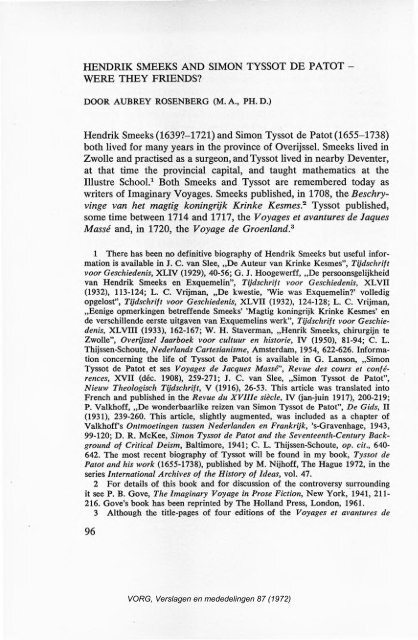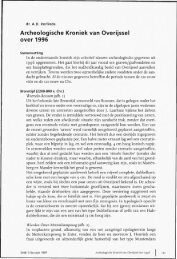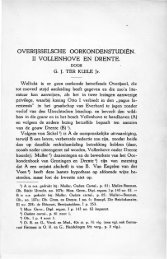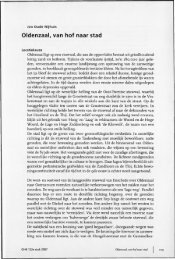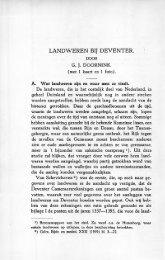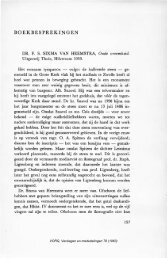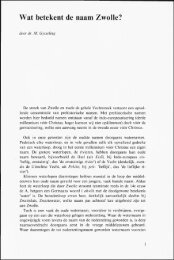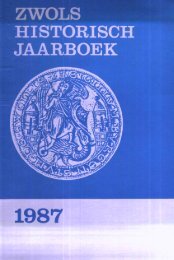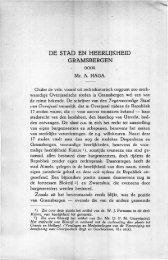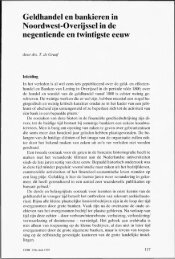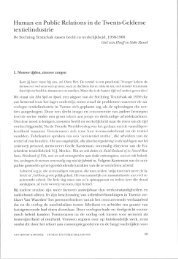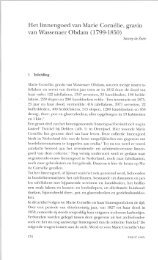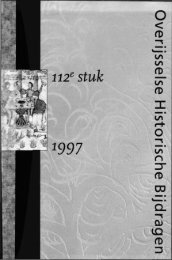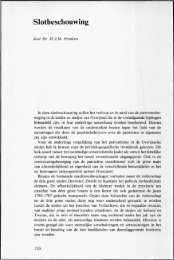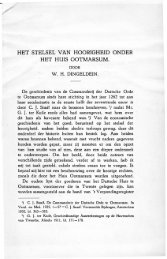Hendrik Smeeks and Simon Tyssot de Patot, were - Historisch ...
Hendrik Smeeks and Simon Tyssot de Patot, were - Historisch ...
Hendrik Smeeks and Simon Tyssot de Patot, were - Historisch ...
Create successful ePaper yourself
Turn your PDF publications into a flip-book with our unique Google optimized e-Paper software.
HENDRIK SMEEKS AND SIMON TYSSOT DE PATOT-<br />
WERE THEY FRIENDS?<br />
DOOR AUBREY ROSENBERG (M. A., PH. D.)<br />
<strong>Hendrik</strong> <strong>Smeeks</strong> (1639?-1721) <strong>and</strong> <strong>Simon</strong> <strong>Tyssot</strong> <strong>de</strong> <strong>Patot</strong> (1655-1738)<br />
both lived for many years in the province of Overijssel. <strong>Smeeks</strong> lived in<br />
Zwolle <strong>and</strong> practised as a surgeon, <strong>and</strong> <strong>Tyssot</strong> lived in nearby Deventer,<br />
at that time the provincial capital, <strong>and</strong> taught mathematics at the<br />
Illustre School.' Both <strong>Smeeks</strong> <strong>and</strong> <strong>Tyssot</strong> are remembered today as<br />
writers of Imaginary Voyages. <strong>Smeeks</strong> published, in 1708, the Beschryvinge<br />
van het magtig koningrijk Krinke Kesmes? <strong>Tyssot</strong> published,<br />
some time between 1714 <strong>and</strong> 1717, the Voyages et avantures <strong>de</strong> Jaques<br />
Massé <strong>and</strong>, in 1720, the Voyage <strong>de</strong> Groenl<strong>and</strong>:"<br />
1 There has been no <strong>de</strong>finitive biography of <strong>Hendrik</strong> <strong>Smeeks</strong> but useful information<br />
is available in J. C. van Slee, "De Auteur van Krinke Kesmes", Tijdschrift<br />
voor Geschie<strong>de</strong>nis, XLIV (1929), 40-56; G. J. Hoogewerff, "De persoonsgelijkheid<br />
van <strong>Hendrik</strong> <strong>Smeeks</strong> en Exquemelin", Tijdschrift voor Geschie<strong>de</strong>nis, XLVII<br />
(1932), 113-124; L. C. Vrijman, "De kwestie, 'Wie was Exquemelin?' volledig<br />
opgelost", Tijdschrift voor Geschie<strong>de</strong>nis, XLVII (1932), 124-128; L. C. Vrijman,<br />
"Eenige opmerkingen betreffen<strong>de</strong> <strong>Smeeks</strong>' 'Magtig koningrijk Krinke Kesmes' en<br />
<strong>de</strong> verschillen<strong>de</strong> eerste uitgaven van Exquemelins werk", Tijdschrift voor Geschie<strong>de</strong>nis,<br />
XLVIII (1933), 162-167; W. H. Staverman, "Henrik <strong>Smeeks</strong>, chirurgijn te<br />
Zwolle", Overijssel Jaarboek voor cultuur en historie, IV (1950), 81-94; C. L.<br />
Thijssen-Schoute, Ne<strong>de</strong>rl<strong>and</strong>s Cartesianisme, Amsterdam, 1954, 622-626. Information<br />
concerning the life of <strong>Tyssot</strong> <strong>de</strong> <strong>Patot</strong> is available in G. Lanson, "<strong>Simon</strong><br />
<strong>Tyssot</strong> <strong>de</strong> <strong>Patot</strong> et ses Voyages <strong>de</strong> Jacques Massé?', Revue <strong>de</strong>s cours et contérenees,<br />
XVII (déc. 1908), 259-271; J. C. van Siee, "<strong>Simon</strong> <strong>Tyssot</strong> <strong>de</strong> <strong>Patot</strong>",<br />
Nieuw Theologisch Tijdschrift, V (1916), 26-53. This article was translated into<br />
French <strong>and</strong> published in the Revue du XVIIIe siècle, IV (jan-juin 1917), 200-219;<br />
P. Valkhoff, "De won<strong>de</strong>rbaarlike reizen van <strong>Simon</strong> <strong>Tyssot</strong> <strong>de</strong> <strong>Patot</strong>", De Gids, II<br />
(1931), 239-260. This article, slightly augmented, was inclu<strong>de</strong>d as a chapter of<br />
Valkhoff's Ontmoetingen tussen Ne<strong>de</strong>rl<strong>and</strong>en en Frankrijk, 's-Gravenhage, 1943,<br />
99-120; D. R. McKee, <strong>Simon</strong> <strong>Tyssot</strong> <strong>de</strong> Patat <strong>and</strong> the Seventeenth-Century Background<br />
of Critical Deism, Baltimore, 1941; C. L. Thijssen-Schoute, op. cit., 640-<br />
642. The most recent biography of <strong>Tyssot</strong> will be found in my book, <strong>Tyssot</strong> <strong>de</strong><br />
Patat <strong>and</strong> his work (1655-1738), published by M. Nijhoff, The Hague 1972, in the<br />
series International Archives of the History of I<strong>de</strong>as, vol. 47.<br />
2 For <strong>de</strong>tails of this book <strong>and</strong> for discussion of the controversy surrounding<br />
it see P. B. Gove, The Imaginary Voyage in Prose Fiction, New York, '1941,211-<br />
216. Gove's book has been reprinted by The Holl<strong>and</strong> Press, London, 1961.<br />
3 Although the title-pages of four editions of the Voyages et avantures <strong>de</strong><br />
96<br />
VORG, Verslagen en me<strong>de</strong><strong>de</strong>lingen 87 (1972)
In her magisterial book, Ne<strong>de</strong>rl<strong>and</strong>s Cartesianisme, the late C. L. Thijssen-Schaute,<br />
in discussing the work of <strong>Tyssot</strong> <strong>de</strong> Patat, stated that he<br />
<strong>and</strong> <strong>Smeeks</strong> <strong>were</strong> friends. Lacking external evi<strong>de</strong>nce, she based this<br />
assumption entirely on certain references to a man called Smeenk in<br />
<strong>Tyssot</strong>'s Lettres choisies.' <strong>and</strong> in the Voyage <strong>de</strong> Groenl<strong>and</strong>. As far as I<br />
know, no one has questioned Dr. Thijssen-Schoute's conclusion that<br />
<strong>Tyssot</strong>'s friend Smeenk <strong>and</strong> <strong>Hendrik</strong> <strong>Smeeks</strong> <strong>were</strong> one <strong>and</strong> the same.<br />
person. The purpose of this article, therefore, is to reopen the question.<br />
What I hope to show is that while it is possible that Smeenk <strong>and</strong> <strong>Smeeks</strong><br />
<strong>were</strong> one <strong>and</strong> the same, it is equally possible that they <strong>were</strong> two different<br />
people. In short, my conclusion will be that, on the evi<strong>de</strong>nce<br />
available, we are unable to <strong>de</strong>termine whether <strong>Tyssot</strong> <strong>de</strong> Patat <strong>and</strong><br />
<strong>Hendrik</strong> <strong>Smeeks</strong> <strong>were</strong> friends or not.<br />
It should be noted, from the outset, that the difference in the spelling<br />
of the names in no way affects the validity of Dr. Thijssen-Schoute's<br />
assumption, since Smeek's name enjoyed a very varied orthographical<br />
career <strong>and</strong> was' just as likely to appear as Smeekens, Smeeck, Smeek,<br />
Smeink or Smekes 5 although, as far as I know, it was never written as<br />
Smeenk which was the spelling used consistently by <strong>Tyssot</strong> in referring<br />
to his friend.<br />
Let us consi<strong>de</strong>r, first, the evi<strong>de</strong>nce of the Lettres choisies. In letter<br />
Jaques Massé bear the date 1710, there are grounds for believing that the first<br />
edition was published between 1714 <strong>and</strong> 1717. For a discussion of this dating see<br />
my article, "The Voyages et avantures <strong>de</strong> Jaques Massé <strong>and</strong> the problem of the<br />
first edition", Australian Journal of French Studies, No.3, 1970. For further<br />
bibliographical information see Gove, op. cit., 217-219.<br />
The full title of <strong>Tyssot</strong>'s Greenl<strong>and</strong> novel is La Vie, les avantures, et le voyage<br />
<strong>de</strong> Groenl<strong>and</strong> du Révérend Pere Cor<strong>de</strong>lier Pierre <strong>de</strong> Mesange. Avec une relation<br />
bien circonstanciée <strong>de</strong> l'origine, <strong>de</strong> l'histoire, <strong>de</strong>s moeurs, et du paradis <strong>de</strong>s<br />
habitans du pole arctique, Amsterdam, Etienne Roger, 1720, 2 vol. in 1. For<br />
further bibliographical information on this novel see also Gove, 235-236 <strong>and</strong> the<br />
relevant chapter in my book.<br />
4 Lettres choisies <strong>de</strong> Mr. <strong>Simon</strong> <strong>Tyssot</strong> <strong>de</strong> <strong>Patot</strong>; Professeur ordinaire en<br />
mathématiques dans l'Ecole Illustre <strong>de</strong> Deventer en Over-Yssel. Ecrites <strong>de</strong>puis sa<br />
jeunesse jusqu'à un âge fort avancé, à différentes personnes, et sur toutes sortes<br />
<strong>de</strong> sujets, La Haye, Matthieu Roguet, 1727, 2 vol.<br />
5 All these spellings are reproduced by Thijssen-Schoute, op cit., 624-626.<br />
The autograph, Smekes, also appears on a document signed by <strong>Smeeks</strong>, in 1707,<br />
in his capacity as a member of the surgeons' guild of Amsterdam. The document,<br />
IV A 18 6 , is in the H<strong>and</strong>schriften <strong>de</strong>partment of the Universiteitsbibliotheek,<br />
Amsterdam.<br />
VORG, Verslagen en me<strong>de</strong><strong>de</strong>lingen 87 (1972)<br />
97
32, 6 the name of Smeenk is coupled with that of someone called<br />
Berent. However, there is nothing in the letter to indicate their relationship.<br />
Since <strong>Hendrik</strong> <strong>Smeeks</strong> had a son called Berent, Dr. Thijssen-<br />
Schoute took the reference in <strong>Tyssot</strong>'s letter to be evi<strong>de</strong>nce that Smeenk<br />
must be <strong>Hendrik</strong> <strong>Smeeks</strong>." Now we know that <strong>Hendrik</strong> <strong>Smeeks</strong>' son<br />
Berent was born in 1691. It would be helpful, therefore, if we could<br />
find out when letter 32 was written. If it <strong>were</strong> written before 1691, the<br />
Berent referred to could not be the son of <strong>Hendrik</strong> <strong>Smeeks</strong>. If it <strong>were</strong><br />
written after 1691, the evi<strong>de</strong>nce, though not conclusive, would speak<br />
in favour of Dr. Thijssen-Schoute's assumption.<br />
But here we face a problem in that the correspon<strong>de</strong>nce is undated<br />
<strong>and</strong> the letters do not conform to a strictly chronological sequence.<br />
That this was a <strong>de</strong>liberate policy is explained in the Avertissement to<br />
the Lettres choisies where <strong>Tyssot</strong> stated that it was pointless to arrange,<br />
in any strict or<strong>de</strong>r, these letters, "où il n'est nullement question d'histoire,<br />
ni <strong>de</strong> chronologie, et où il n'est fait mention d'aucun événement<br />
digne <strong>de</strong> remarque que l'on ne trouve dans les Mercures ou journaux".<br />
<strong>Tyssot</strong> also claimed to have purposelyvaried the or<strong>de</strong>r of the letters<br />
so as to entertain the mature rea<strong>de</strong>r with a diversity of subject matter<br />
<strong>and</strong> style <strong>and</strong> to "donner aux jeunes un modèle <strong>de</strong> lettres". <strong>Tyssot</strong>,<br />
nevertheless, inten<strong>de</strong>d the letters to serve as his biography <strong>and</strong> told the<br />
rea<strong>de</strong>r that if he took the trouble to read them through carefully, he<br />
would find "en abrégé, l'histoire <strong>de</strong> la vie d'un particulier".<br />
The problem is to <strong>de</strong>ci<strong>de</strong> how reliable these letters are as biographical<br />
material. According to Baumgarten," they have some value if one<br />
bears in mind that many parts of the Lettres choisies are pure fabrication.<br />
Dr. Thijssen-Schoute, on the other h<strong>and</strong>, found them quite<br />
unacceptab1e for this purpose, not only because they are not dated but<br />
also because some of the letters give the impression of having been<br />
revised for publication." My own investigation of the letters has led me<br />
6 Since there are many inaccuracies <strong>and</strong> typographical errors in the numbering<br />
of the letters, I shall supply, in addition, the relevant page numbers. All the letters<br />
cited are from the first volume. The references to Smeenk <strong>and</strong> Berent are found<br />
on pages 153 <strong>and</strong> 154.<br />
7 Thijssen-Schoute, op. cit., 640.<br />
8 S. J. Baumgarten, Nachrichten von einer hallischen bibliothek, Halle, 1748-<br />
1751, 4 vol., vol. III, 135-136.<br />
9 Thijssen-Schoute, op. cit., 640.<br />
98<br />
VORG, Verslagen en me<strong>de</strong><strong>de</strong>lingen 87 (1972)
to conclu<strong>de</strong> that, for the most part, they are quite reliable as a source<br />
of biographical information. Although the letters are not in strict<br />
chronological or<strong>de</strong>r many contain clues as to their date of composition.<br />
It may be objected that these clues could have been <strong>de</strong>liberately inserted<br />
to mislead the rea<strong>de</strong>r. For this reason I have, wherever possible, sought<br />
external confirmation in dating the letters.t?<br />
Letter 32, the one that contains the reference to Berent, is one of a<br />
group of three letters written by <strong>Tyssot</strong> to one of his military friends,<br />
Captain du Mainon, who was garrisoned at Zutphen in the neighbouring<br />
province of Gel<strong>de</strong>rl<strong>and</strong>. The other two letters of the group are<br />
22 <strong>and</strong> 24. Letter 22 11 refers to the <strong>de</strong>sire of the Zutphen magistracy<br />
to interview, for their Church, a M. <strong>de</strong>s Touches who was a French<br />
pastor at Deventer. <strong>Tyssot</strong>, says, in the letter, that he <strong>and</strong> two of his<br />
friends (one of whom will be i<strong>de</strong>ntified as Smeenk in letter 24) intend<br />
to accompany <strong>de</strong>s Touches to Zutphen. Now we know, from external<br />
evi<strong>de</strong>nce, that in 1686 the Zutphen magistracy <strong>were</strong> looking for a<br />
pastor. On April 13th they invited Samuel Basnage to establish a<br />
church in Zutphen. On April 24th the synod finally ratified his appointment."<br />
Des Touches must have been one of the unsuccessful c<strong>and</strong>idates<br />
interviewed for this position. I conclu<strong>de</strong>, therefore, that letter 22 was<br />
written before April 13th 1686. This letter ends with a brief reference<br />
to the <strong>de</strong>ath of one of <strong>Tyssot</strong>'s children <strong>and</strong> of his father. Now one of<br />
his children, Jacques Barthélemy, died on December 12th 1685 <strong>and</strong><br />
his father died on March 11th 1686.13I conclu<strong>de</strong>, therefore, that letter<br />
22 was written some time between March 11th <strong>and</strong> April 13th 1686.<br />
Letter 24,l4 the second of the group of three, is one that Dr. Thijssen-<br />
Schaute seems to have overlooked. It <strong>de</strong>scribes the aforementioned<br />
visit to Zutphen of <strong>de</strong>s Touches, <strong>Tyssot</strong> <strong>and</strong> his friends, one of whom<br />
is now i<strong>de</strong>ntified as Smeenk. In this letter, <strong>Tyssot</strong>, in his inimitable<br />
10 A gui<strong>de</strong> to the chronology of the Lettres choisies is available in Appendix<br />
D of my book.<br />
11 Pp. 90-91.<br />
12 See M. F. H. Gagnebin, "Listes <strong>de</strong>s églises wallonnes <strong>de</strong>s Pays-Bas et <strong>de</strong>s<br />
pasteurs qui les ont <strong>de</strong>sservies", Bulletin <strong>de</strong> la commission pour ['histoire <strong>de</strong>s<br />
Eglises Wallonnes, III (1888), 340.<br />
13 This information is available in a history of the family written by one of<br />
<strong>Tyssot</strong>'s nephews. The manuscript is in the possession of Dr. P. N. Tissot van<br />
<strong>Patot</strong>.<br />
14 Pp. 97-101.<br />
VORG, Verslagen en me<strong>de</strong><strong>de</strong>lingen 87 (1972)<br />
99
way, thanks du Mainon for his hospitality. The letter was clearly written<br />
soon after the visit, certainly some time in 1686.<br />
Letter 32 refers to the time, "lorsque je vous allai voir avec notre<br />
Domine <strong>de</strong>s Touches". This is the letter that couples the names of<br />
Smeenk <strong>and</strong> Berent. It was obviously written after letters 22 <strong>and</strong> 24 but<br />
the problem is to <strong>de</strong>ci<strong>de</strong> how long after. Was it a few weeks, a few<br />
months or even several years? Because of the reference to the Des<br />
Touches visit, it seems to me that there is prima facie evi<strong>de</strong>nce for<br />
placing this letter in the same period as the other two. My inclination<br />
is to date it in 1686 or, at the latest, 1687. If this dating is correct, the<br />
Berent named in the letter could not have been <strong>Hendrik</strong> <strong>Smeeks</strong>' son<br />
who, as we have seen, was not born until 1691. It does not follow from<br />
this, of course, that Smeenk was not <strong>Smeeks</strong> but it does seem less<br />
likely.<br />
Had Dr. Thijssen-Schoute not overlooked letter 24 she might have<br />
found some support for her argument. In this letter, <strong>Tyssot</strong> refers to<br />
Smeenk's profession as that of a "Maître Savonnier". At first glance it<br />
is difficult to see what connection there could be between this occupation<br />
<strong>and</strong> that of a surgeon. We must remember, however, that at that<br />
time surgeons <strong>were</strong> also barbers. If we accept, for the moment, that<br />
<strong>Smeeks</strong> <strong>and</strong> Smeenk <strong>were</strong> the same person, it is possible to infer, from<br />
the jocular tone of the letter, that <strong>Tyssot</strong> was having fun at his friend's<br />
expense by suggesting he was much better at lathering faces than he<br />
was at performing surgical operations. We could go even further by<br />
noting that it would be entirely in keeping with <strong>Tyssot</strong>'s Rabelaisian<br />
sense of humour if the expression "Maître Savonnier" <strong>were</strong> inten<strong>de</strong>d to<br />
imply that Smeenk had a. penchant for administering enemas. On the<br />
other h<strong>and</strong>, if we interpret the expression literally, if Smeenk really<br />
<strong>were</strong> involved in the manufacture of soap, this letter would be very<br />
damaging to Dr. Thijssen-Schoute's argument.<br />
Letter 97/ 5 the fourth <strong>and</strong> final letter having reference to Smeenk,<br />
was probably written in 1691 since it <strong>de</strong>als with <strong>Tyssot</strong>'s unsuccessful<br />
application to the Amsterdam Athenaeum for the position of mathematics<br />
professor, a post that was vacant owing to the <strong>de</strong>ath of Alex<strong>and</strong>er<br />
<strong>de</strong> Bie in 1690.1 6 The letter mentions that Smeenk had encouraged<br />
15 Pp, 500-506. Thijssen-Schoute, op. cit., 642, note 1, incorrectly refers to<br />
this letter as 107.<br />
16 For further <strong>de</strong>tails of Alex<strong>and</strong>er <strong>de</strong> Bie (1620-1690), see P. C. Molhuysen<br />
100<br />
VORG, Verslagen en me<strong>de</strong><strong>de</strong>lingen 87 (1972)
<strong>Tyssot</strong> to apply for the post. There is nothing in this letter that offers<br />
any clue as to the i<strong>de</strong>ntity of Smeenk.<br />
In the Voyage <strong>de</strong> Groenl<strong>and</strong> there is a reference to someone:<br />
... qui était, si je ne me trompe, du côté <strong>de</strong> Gueldre, et qui<br />
s'appellait Monsieur Smeenk, auquel je donnai quelques leçons<br />
<strong>de</strong> géométrie. . . La seule raison qui me porta à cela fut que,<br />
nonobstant la peine que le pauvre garçon se donnait, il ne<br />
pouvait comprendre une proposition un peu difficile, ou qui<br />
renfermait plusieurs rapports; et que son Maître lui reprochait<br />
souvent <strong>de</strong>vant ses camara<strong>de</strong>s la dureté <strong>de</strong> sa conception lorsqu'il<br />
avouait ingénuement qu'il ne l'entendait pas, ou qu'il le priait<br />
plus d'une fois d'en venir à une répétition."<br />
Dr. Thijssen-Schoute took this to be a further reference to <strong>Hendrik</strong><br />
<strong>Smeeks</strong>. But, if <strong>Tyssot</strong> <strong>and</strong> <strong>Smeeks</strong> <strong>were</strong> friendly, why could not the<br />
reference apply equally well to his son Berent? The difficulty here is<br />
how to interpret the tone of the passage. <strong>Tyssot</strong> writes of Smeenk as<br />
though he <strong>were</strong> <strong>de</strong>ad or, at least, as if he <strong>were</strong> no longer a friend. Is<br />
the tone jocular or was there some disagreement between the two men<br />
that led to this unflattering portrayal? If Smeenk <strong>were</strong> no longer alive<br />
this would fit in with the absence of any reference to him in the Lettres<br />
choisies after 1691. But <strong>Hendrik</strong>- <strong>Smeeks</strong>, the.surgeon, lived until 1721<br />
<strong>and</strong> the Voyage <strong>de</strong> Groenl<strong>and</strong> was published in 1720. If <strong>Smeeks</strong> <strong>and</strong><br />
Smeenk <strong>were</strong> one <strong>and</strong> the same, why did <strong>Tyssot</strong> suggest that Smeenk<br />
was "du côté <strong>de</strong> Gueldre" when, as far as is known, <strong>Hendrik</strong> <strong>Smeeks</strong><br />
came from Overijssel?<br />
In short, while nothing I have discussed really invalidates the proposition<br />
that <strong>Tyssot</strong>'s friend Smeenk <strong>and</strong> <strong>Hendrik</strong> <strong>Smeeks</strong> <strong>were</strong> one <strong>and</strong><br />
the same, there is no clear evi<strong>de</strong>nce, other than the similarity of names,<br />
to support this assumption. The fact that both <strong>Smeeks</strong> <strong>and</strong> <strong>Tyssot</strong> wrote<br />
Imaginary Voyages of a utopian <strong>and</strong> satirical nature attests to the popularity<br />
of the genre rather than to any personal relationship between the<br />
two men. The fact that they both displayed their literary abilities<br />
through the use of digressions suggests only that <strong>Tyssot</strong> may have read<br />
<strong>and</strong> P. J. Blok, Nieuw Ne<strong>de</strong>rl<strong>and</strong>sch biografisch woor<strong>de</strong>nboek, Lei<strong>de</strong>n, 1911-1937,<br />
10 vol., vol. X, 64-65.<br />
17 Vol. I, 23-24.<br />
VORG, Verslagen en me<strong>de</strong><strong>de</strong>lingen 87 (1972)<br />
101
<strong>Smeeks</strong>' novel." Therefore, until further evi<strong>de</strong>nce is available, we have<br />
nô more reason for supposing that <strong>Smeeks</strong> <strong>and</strong> <strong>Tyssot</strong> <strong>were</strong> friends than<br />
we have for supposing that <strong>Tyssot</strong>, at one stage in his life, had a friend<br />
called Smeenk, a soap maker by profession, who lived in Gel<strong>de</strong>rl<strong>and</strong><br />
<strong>and</strong> who had no connection with <strong>Hendrik</strong> <strong>Smeeks</strong> of Zwolle.<br />
18 Both <strong>Smeeks</strong> <strong>and</strong> <strong>Tyssot</strong> incorporated many irrelevant digressions into<br />
their work. <strong>Smeeks</strong> <strong>de</strong>voted fewer than half the 286 pages of his novel to a<br />
<strong>de</strong>scription of the utopian society. Almost a hundred pages are taken up with a<br />
robinsona<strong>de</strong> episo<strong>de</strong>. Other digressions inclu<strong>de</strong> a dissertation on the treatment of<br />
scurvy, a discussion of currents in the waters around The Netherl<strong>and</strong>s, <strong>and</strong> a<br />
prescription for the treatment of drunkenness. For <strong>de</strong>tails on <strong>Tyssot</strong>'s use of<br />
digressive techniques, see my article, "Digressions in Imaginary Voyages" in The<br />
Varied Pattern, A. M. Hakkert, Amsterdam <strong>and</strong> Toronto, 1971.<br />
102<br />
VORG, Verslagen en me<strong>de</strong><strong>de</strong>lingen 87 (1972)


